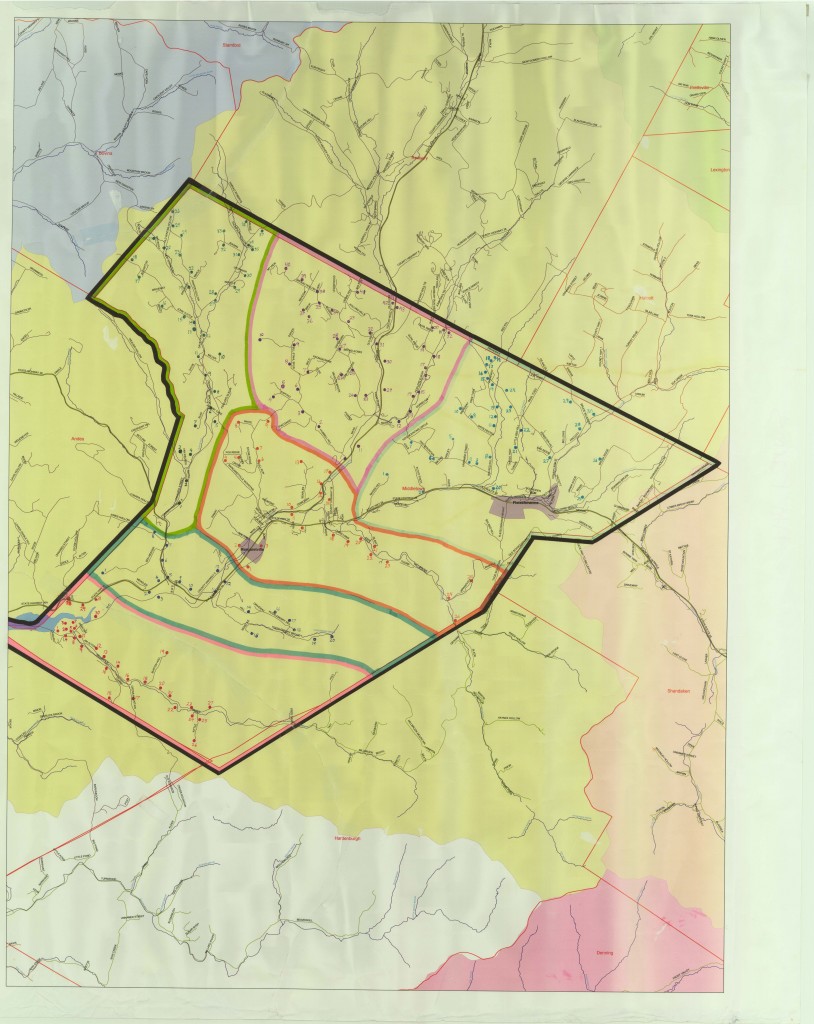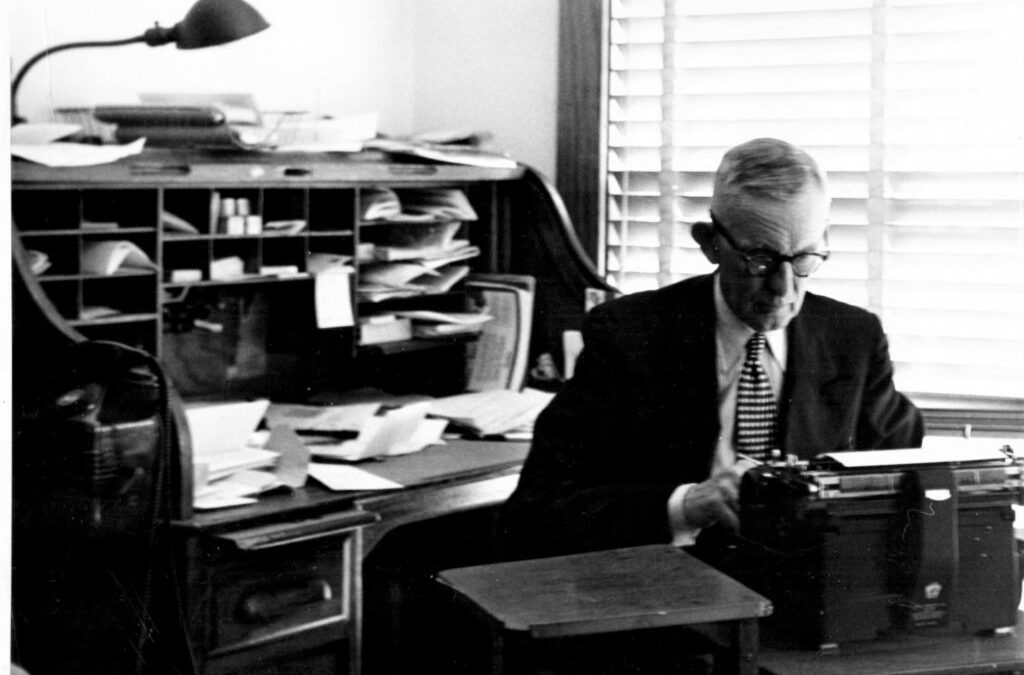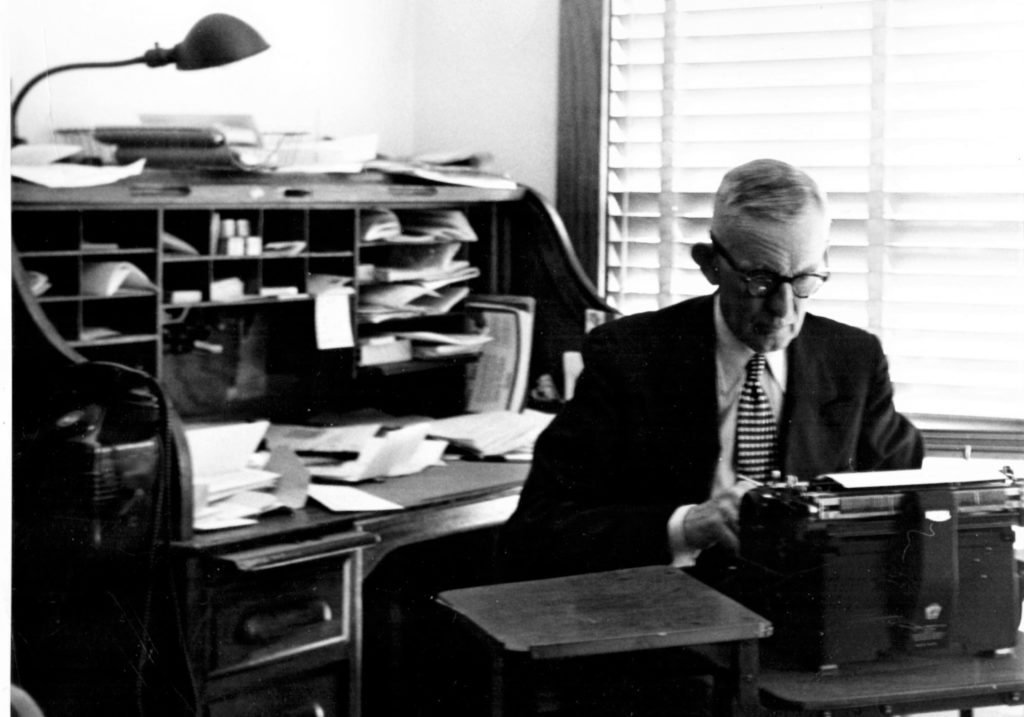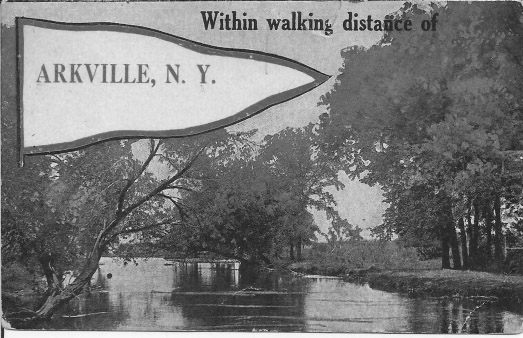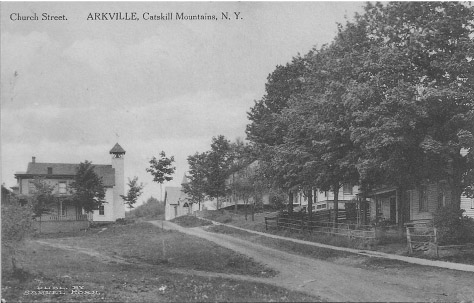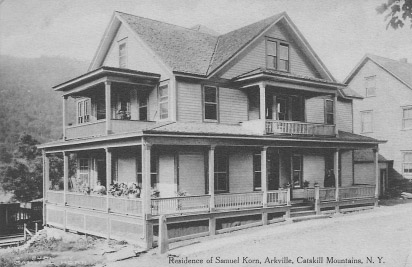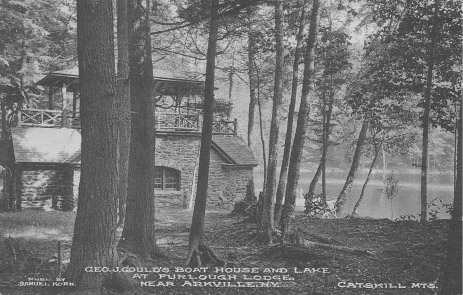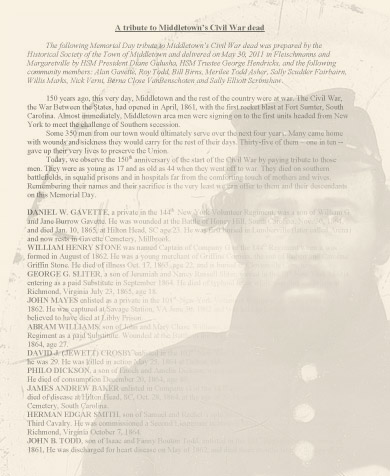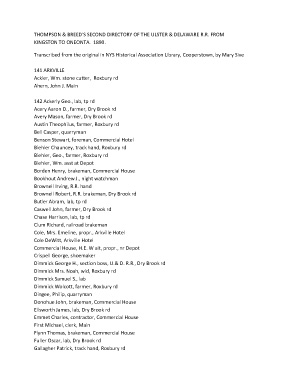SYDNEY
May 31, 1918
At the Women’s Christian Temperance meeting it was decided to purchase more yarn and keep busy knitting socks for the soldiers. What we lack is means to buy material. We have many willing workers. Dry Brook correspondent.
June 28, 1918
Until further notice, Sunday, Tuesday and Friday will be beefless – beef not to be served by hotels or restaurants in any form. Also, use no crackers, pastry, macaroni, breakfast or other cereal food containing wheat and use no wheat flour, except in thickening and binding.
SALLY
August 9, 1918
From our Roxbury correspondent: The community was shocked and grieved to learn on Monday that Earl Dudley, who enlisted in the US Marines in the spring of 1917, had been killed in action in France, with victory in sight, on June 26.
NARRATOR
August 23, 1918
Publishers of weekly newspapers must arrange for a reduction of 15 percent in their circulation beginning Sept. 15 in order to meet requirements of the pulp and paper section of the war industries board.
Sept. 11, 1918
Advertisement: “The Kaiser: The Beast of Berlin,” an astounding expose of his methods. A play that no red blooded American should miss. Opera House, Margaretville, Wed. Sept. 18, Two shows, 7 and 9. Admission 30 cents.
ROY
Dec. 20, 1918
Frank Long was discharged from the army at Garden City Monday and started at once for Margaretville. He is the first overseas man to arrive home. He has been in England for several months, in charge of machine guns used on airplanes. L. B Halpern arrived in Margaretville Thursday. Claude Kaufman arrived home Monday evening. With one exception all the boys in France have been heard from. Middletown has a good chance of no more casualties.
NARRATOR
In a bewildering world that sometimes seemed upside down, News readers found comfort in the historical sketches written during the 1920s by Lincoln Long, a minister, a state assemblyman and a beloved local resident who took it upon himself to visit, interview and record the reminiscences and family stories of his New Kingston neighbors.
ROY
THE INGLES OF NEW KINGSTON
NARRATOR
Meanwhile, C. A. was actively pursuing other business interests. With movies at the opera house drawing good sized audiences, he decided to build a modern theater on Main Street.
August 11, 1922
New Theatre to be named after great singer
Margaretville’s new playhouse, which has been under construction for some months, will be dedicated Friday evening, August 25. It has been named the Galli-Curci Theatre in honor of the great diva who is building a beautiful mountain home near here. Amelita Galli-Curci will be among those present at the opening. Estelle Leibling, a prima donna who has made Margaretville her summer home for many years, will appear on the program. The new theatre is safe, fireproof and comfortable. The seating capacity is about 600. The seats rest on a slanting floor that will give everybody opportunity to see the stage and screen. The projection of the pictures is accomplished by two motor driven simplex machines that give a steady, flickerless picture. The stage is of ample size to carry a large road show and it is probable that we will have several shows during the season. The floor of the stage is the best kind of hard maple, 50×30 feet, which will give plenty of room for dancing.
GENE
October 25, 1929
Billions lost in Stock Market on Wednesday
Many local investors in the stock market are mourning the loss today of a handsome margin of paper profits, swept away in a few minutes in the stock market Wednesday. A new and wholly unexpected avalanche of selling swept over the market, carrying scores of stocks down from $10 to $96 a share, and wiping out more than $3 billion in paper values in the brief interval of about an hour.
Sept. 12, 1930
The business depression has reached the local creamery. They have shut down the dried milk department and are trucking the skim milk to the Roxbury plant. Robert Russell is transferred to Roxbury and three of the men are now on part time. New Kingston correspondent.
SYDNEY
April 13, 1934
Fleischmanns Fire Destroys Six Buildings
The neighboring village of Fleischmanns suffered a $100,000 fire early Wednesday morning when six buildings in the center of the business section on Main Street were burned to the ground and three families narrowly missed being caught in the flames. The wind blew a gale and a dozen buildings in the village were on fire at one time or another but without serious damage. The structures destroyed are Halpern Brothers department stores, two buildings; N. Franklin bowling alley, and Franklin residence and shop; Moe’s restaurant, a building owned by Halperns and rented to Moe Weintraub; the Vermilya building, known for years as Vermilya’s jewelry store and now occupied by Charles Muller; and the J. Brill home. Mr. and Mrs Ralph Reed and daughter escaped in their nightclothes and saved nothing, not even shoes for their feet. Mr. and Mrs. Morris Halpern and daughter and Mr. and Mrs. Paul Pultz and daughter lived over the Halpern stores. They all got out safely, but saved nothing. It is doubtful if the buildings will be replaced. None of the owners had any thought of rebuilding yesterday, and one said that the area would be an excellent place for a gasoline station.
SALLY
July 19, 1935
Supplies for the erection of the Civilian Conservation Corps camp on the Roy Leonard farm, a mile below the village, are beginning to arrive and work on the camp, which will bring about 250 men to this community will soon begin. One of the first projects of the program will be to cut a ski trail from Margaretville to the Dry Brook peaks. This trail will be about 16 feet wide and will afford an excellent opportunity for the sport, which will attract many winter visitors.
Jan. 10, 1936
More than 200 seek 30 WPA jobs. Claire Whittaker of the National Unemployment Bureau of Delhi was in town Tuesday to sign up all who were eligible for employment on the local WPA project. The number of applicants was so large and the number of jobs so small there are sure to be disappointments. Disappointed ones take it as a personal grievance and complain that those get jobs that have pull. But just how 25 or 30 jobs can be distributed among 200 men is a problem. Fleischmanns Correspondent.
GENE
Feb. 11, 1938
Three men caught in falling bridge.
John Roberts, son John and Fred Bell were thrown into the ice cold waters of the creek Monday when the old Arkville covered bridge collapsed as they were tearing it down. The elder Roberts was caught across his back by a big timber and pinned underneath the waters. The other two men who were thrown in with him released the timber from his back and he was brought to the Margaretville hospital. It was found his injuries were not serious. The other two had some scratches and bruises and a polar bear bath. The Hampton Construction Co. was taking down the bridge to use the excellent hundred year old heavy lumber which it contains.
SYDNEY
March 27, 1936
There was a haze over the Catskills all day Wednesday caused by the dust storm from western states. It first looked like a distant rain, some thought it smoke. But it seems to be fine particles of dust from the western farms. Maple sugar producers were worried. Some claimed that it interfered with the product and made it gritty.
ROY
Oct. 14, 1938
Great building activity hits this village
Never in the history of Margaretville has there been the building activity now being entered into. The half million dollar central school nearly equals the entire assessment valuation of the village. There is also a new garage under construction on the old Pocantico Inn lot, and new sidewalks throughout the village, being built under the direction of Claude Caswell. Vicinity villages are also going along on the school proposition. Andes has a handsome structure finished some months ago and occupied. Roxbury is about ready to let the contract for a new school structure. Delhi will build at a cost of about $750,000. Downsville is also to have a new school building soon. Fleischmanns completed an excellent building not long ago.
Dec. 16, 1938
Approval of the new Town of Middletown WPA project to improve 1.2 miles of the Thomson Hollow Road at an estimated cost of $10,661 was received Monday by James Conley, field director of the Works Progress Administration. 23 men taken from the local relief rolls will start work on the project today. They will be employed for four months.
NARRATOR
While New Deal programs built schools, improved infrastructure and provided jobs to local men, area farms just kept keeping on, many of them counting on cauliflower to see them through.
May 29, 1931
Classified ads:
For Sale: For Sale, Twenty Thousand cauliflower plants, read to set. Wilbur Bouton, Margaretville. For Sale: Cauliflower plants ready for delivery now. John Haynes, Dry Brook, Arkville. For Sale – Cauliflower plants, ready to set, $2.50 per 1,000, also potatoes for 30 cents per bushel. W. H. Fairbairn, Seager.
SALLY
July 6, 1934
110 in the shade at Halcottville
Most of the ladies of this vicinity have been very busily engaged during the past several days in picking strawberries. The crop was reported very plentiful considering the long dry spell and many quarts were picked and canned. Last Thursday the thermometer on the post office here registered a new mark of 110 degrees. We have never seen it any higher. Reminds us that February 10 the same temperature device showed a new low of 36 degrees below, but why bring that up? Several of the local farmers, including Chester Mead and Kelly Brothers, have commenced the harvest of the hay crop. Cauliflower is growing very rapidly, corn is looking fine.
Sept. 20, 1935
The cauliflower crop that failed in August made good in September and that part of Delaware County which has altitude enough to bring cool nights is harvesting a bumper crop at good prices. The market this week for prime quality has been from $2 to $2.20 a crate. One Dry Brook firm shipped 260 crates one day last week. An interested grower told the New this week there were 56 cauliflower buyers and solicitors in town one day last week.
Sept. 11, 1936
Monday afternoon saw the greatest shipments of cauliflower ever to leave Delaware County. Every truck in a wide radius was hired. There had been no Sunday or Monday morning market and the 3-day flood of the vegetable was enormous. Prices were low, many scarcely realized enough to pay cartage, crate and commission.
NARRATOR
The 1930s also saw the introduction of a new feature in the Catskill Mountain News, which gave C. A. Sanford a chance to editorialize without preaching, and to be colorful and creative and talk about anything that struck his fancy.
The Spotlight
Nov. 23, 1934
A few weeks ago, someone mistakenly, we hope, shot a cow. While the animal could not be any deader, it would seem to be a more respectable demise if it was unintentionally done by the executioner. It is hardly possible that the cow’s horn and benign forehead could have been mistaken for that of a buck’s. Mayhap some nimrod, suffering from acute astigmatism, aimed at a deer and killed the milker. However, this sounds rather fishy as the most edible parts of the critter were missing.
Yours confidentially, The Philosopher
Mountain Dew
March 8, 1935
I have a letter in which the writer takes us to task for our signature. He says, ‘philosopher is high hat.’ We took the matter up with Mr. Webster and he says, ‘Philosopher – one who meets all vicissitudes with calmness.’ Our correspondent is right. So we change to a signature we know will fit. The Mountaineer
Nov. 18, 1938
Dr. G. B. Mauer Killed Saturday while Hunting. Well Known physician dies instantly from shotgun wound. Community in gloom.
Dr. Gordon B. Mauer, beloved physician of this village, was instantly killed early last Saturday morning when his shotgun was accidentally discharged as he fell while hunting partridges on the Risely lot in the neighborhood of Hall’s Bridge.
Mountain Dew – Maurer tribute
GENE
Dec. 12, 1941
Fire chiefs gather here, make plans for emergency.
Every community will have protection at all times
All residents asked to assist in signing cards:
All Persons will be classified as to ability in an emergency
Catskills could take evacuees in empty hotels:
Former High school building in this village would care for many.
An order was sent out Tuesday from Mitchel Field ordering all air observation posts in the county to be manned 24 hours a day. This setup, a project of the American Legion, was set up months ago. Observation posts in this section are as follows: near the home of Mrs. Kathryn Dickson, Arena, Mrs. Dickson is chief observer; a high point in Halcott Center, not far from the home of Darwin Faulkner who is chief observer; a point on Hubbell Hill in charge of John Hubbell, chief observer; and a high point near the home of Albert Rosa in Dry Brook.
NARRATOR
Mountain Dew
Jan. 2, 1942
Most Americans did not believe there would be a war. Now, I suppose, those same doubt if it will affect them. It is some stranger in some far-away place who will be hurt.
Here are some pictures in my mind. With no tires, will this community go back to horse and buggy, grass grow in the streets and tradespeople do business as 40 years ago? Or will folks trade at home, and build up the community to something it does not now know? Will there be an influx of refugees from the sea coast that will make business hum?
Will New York’s plan to hurry the great dam on the Delaware bring prosperity and industry to the valley which is being bled by a rush of her boys to the front?
Will food and other rationing follow the tire rationing? How much will we be locally disturbed by the swing of the great armies and navies?
None knows the answer. Mt. Pakatakan stands out these starry winter nights and seems to lift a protecting arm as in benediction over the community. The mountain, here a million years before the birth of Christ, here through all the troubles of other wars, here in prosperity and hard times, in shortage and plenty.
And here it will remain to protect us in the great modern conflict and to inspire us in the uncertain days that are to follow.
SYDNEY
Jan. 16, 1942
The White and Orange, Fleischmanns High School. Editorial by Dorothy Schneider
The United States has been at war for seven weeks. The American people now have two different pasttimes to keep them busy. Instead of going to see our baseball and football players in their respective uniforms, instead we now go to see them in their country’s uniforms; but instead of going to see them in action, we stay home and carry on activities that will keep them in action, such as buying defense stamps and bonds, knitting, sewing and donating funds to the Red Cross. That is why this war is going to look like a baseball game. It will be America, England, Russia and the other Allies out in the field, and Germany, Japan and Italy up at bat. Then, with Roosevelt pitching, Churchill catching and Stalin umping, it will be three up and three down for the Axis.
SALLY
March 6, 1942
William Todd, only son of Mr and Mrs. Ney Todd of Dry Brook, was killed in action with General Douglas MacArthur in the Philippines Dec. 8, the date of the treacherous surprise attack on the Philippines by the Japs. He was born December 24, 1922 and thus had not reached his 19th birthday when he gave up his life for his country. He is the first in the county to be killed in action in the present war.
ROY: Rules of rationing
Red Stamp Rationing – Red coupons in War Ration Book 2, covering meats, butter, fats, canned milk and cheese, are valid as follows: R July 11 to 31; S July 18 to 31; P and Q remain valid throughout July
GENE: Blue Stamp Rationing – N, P and Q blue stamps in War Ration Book 2, covering processed foods and dried beans, Etc., valid through Aug. 7.
SYDNEY: Shoes: No. 18 coupon in War Ration Book 1, good for one pair, must last through Oct. 31. Families may pool coupons of a household.
SALLY: Coffee – Liberalized one pound every three weeks basis, Coupon No. 21 will be good through July 21, Coupon No. 22 from July 22 to Aug. 11
ROY: Sugar – Coupon No. 13 in War Ration Book 1, good for 5 pounds of sugar, through Aug. 15. Five pounds for season’s home canning is available at stores on Coupons 15 and 16. If this is insufficient, an additional maximum of 15 pounds a person may be obtained on application to local rationing board.
GENE: Gasoline – A Coupons are worth 3 gallons each, B and C Coupons 5 gallons. The A coupons numbered 5 must last through July 21. B and C bear own expiration dates. May save A coupons for one vacation after July 15.
ROY: Fuel oil – application blanks for 1943-44 are being mailed to consumers. Users are urged to fill tanks during summer.
NARRATOR
Bertha and I were proud and terrified when our son Roswell enlisted in the Army in November of 1942. He and Betty Dickson of Arena had been married just over a year when he went into the service. She and their baby, named Roswell Randall, lived with her parents for the duration. Like many of our neighbors, and readers of the News, we waited, and prayed for his safe return.
SALLY
June 9, 1944
Invasion Day, Tuesday, was without excitement in the Catskills. Many of the mountain churches were open for prayer all day and many residents repaired to the churches for that purpose. Flags were displayed throughout the region. The invasion of Hitler in Europe was a general topic of discussion but none was found but that had complete faith in the ultimate success of the Allied arms.
June 9, 1944 Lt. Percy Mead awarded Purple Heart; Official dispatch tells how he was wounded over Berlin; Shell in compartment; Stayed at controls though wounded, brought ship back to England
July 28, 1944
Everett Paine killed second day of invasion, Margaretville paratrooper meets death in France June 7 . . . Dry Brook man, PFC Charles Ingram is missing in action in Italy. . . . Mr. and Mrs. Omar Griffin have received word from their son, Lt. Donald Griffin, who is a prisoner in Germany, that he is getting along well, and is in good health and well treated.
SYDNEY
August 17, 1945
Mountain crowds celebrate V-J Day all night
There was wild rejoicing in all the mountain communities Tuesday evening as the Japanese admitted defeat at 7 o’clock. Margaretville, Arkville and Fleischmanns fire departments combined into a parade and were followed by a large number of cars and trucks filled with hysterical, yelling, crying, laughing folks. Sidewalks in all the villages were filled during the evening. Fire crackers, denied last July 4, were brought out. Shotguns, pistols, rifles made as much noise as meager ammunition would permit. Crowds everywhere held up two fingers in the famous Churchill victory sign. There were streamers, confetti, great masses of tin cans and other junk dragged behind cars. Car batteries must have been depleted by the continual blowing, which lasted a great part of the night. So far as the News can learn there was no serious accident or damage. Whisky was freely offered on the street as friend met friend and toasted the great event.
NARRATOR
December 28, 1945
Mr. and Mrs. Roswell Sanford and son Randy of Arena, Mr and Mrs. C. V. McQuide and son Stephen of Manchester, CT, Miss nancy Sanford of NYC and William Harry of Summit, NJ formed a merry Christmas party at the home of Mr. and Mrs. C. A. Sanford in this village.
A very happy Christmas, indeed.
We breathed a little easier, and found that humor was often just what the doctor ordered for trying times:
SALLY: The farmer wants but little here below – and gets it.
GENE: Bragging may not bring happiness, but will a trout fisherman with a 3-pounder sneak up an alley on April 1?
ROY: If every husband wore brassieres, lipstick and sat four hours in a permanent wave chair, he would know what hard work it is to spend all that money.
NARRATOR
Mountain Dew
Sept. 22, 1944
In a 25-mile ride home near midnight on a recent evening I counted 17 cats in the highway. Tom cats, she cats, black cats, white cats, tabby cats, maltese cats, little cats, big cats, sleek cats, frump cats, all manner of cats were in the road and all on the move. The cats run in the fields for game. Will someone tell me why they so congregate in the roads? I would like to drive along a road some night following a sunshiny day where there had been no traffic for a few hours and count the cats. In addition to the cats an occasional fox crosses the road in front of the lights. I have been told they love a cat supper. What weird and unknown mystery of the night takes place on the highways of the nation once the sun has dropped into his golden bed, decent folks and good hound dogs have gone to sleep?
Yours Truly, The Mountaineer.
And on June 10, 1949 there was this:
Cub reporter joins News
Alton Weiss, a senior at the Syracuse School of Journalism, has joined the News for the summer to learn something of the practical side of a weekly newspaper. The News asks for him the kindly consideration of its friends when he comes inquiring.
Al returned as a full time reporter and photographer in the fall of 1951, and stayed for more than 30 years, serving as editor from 1970 until the mid-80s.
GENE
Jan. 27, 1950
Belleayre Mountain Ski Center Dedicated by Lt. Governor Hanley Saturday
The dedication and official opening of the Belleayre Mountain Ski slope Saturday afternoon was the greatest day the Catskills have known since the Ulster & Delaware Railroad ran its first train to Pine Hill nearly a century ago. There was no official count of the crowd which was estimated at 2,000 people. They came in nearly 500 automobiles which crowded the parking space to its limits. The program at the reviewing stand had been opened by a color guard composed of Willis Marks, Richard Whitney, Robert Hill and John Pecoroni of the local American Legion.
Lt. Gov. Joe Hanley made the official opening address Saturday and touched a button which set in motion the $150,000 chair lift, the only one in the state. Mr. Hanley was the first to move up the 2,950 foot lift. Following the officials, 670 folks took advantage of the chair lift which operated until dark. Nearly 150 people went to the ski center Sunday and paid 75 cents each to ride up and back on the chair lift.
SYDNEY
June 30, 1950
Commencement at Andes Central School Tuesday evening was a big and well attended affair. Prizes awarded totaled $150, the largest distribution among this region’s schools.
SALLY
Dec. 1, 1950
Record Flood Greatly Damages Mountain area
Margaretville, Arkville and Dry Brook were hardest hit by a sudden flood in the East Branch of the Delaware Saturday evening between 6 and 10 o’clock. The flood was the quickets and highest in the known history of the village. The top of the water was 56 inches above the floor in the Jenkins garage on Bridge Street. Main Street became a river. Two boats paddled up and down with ease. Bridges and houses which had stood for a century or more were picked up and carried away. Did New York City rainmakers cause the great flood?
NARRATOR: New York City and its quest for water consumed the region, and of course the News, for many years.
Jan. 13, 1950
Gottfried out as attorney for NY: Comes Here
The matter of the condemnation of lands in this valley, which has moved slowly for 3 years, received a shot in the arm Monday at a meeting of the Delaware Valley Chamber of Commerce at the Arena schoolhouse. Ralph Sanford, president, was in charge of the meeting. He had invited all attorneys of the valley to come and speak to the assembled property owners. The school house was jammed with 175 folks and there was a long line of automobiles on both sides of the street.
The first speaker was Attorney Herman Gottfried, counsel in charge of the Water Supply divi¬sion of New York city. He sur¬prised the audience by announcing his resignation from the position named. He stated that he would quit on March 31 and come to the valley and represent any property owners who cared to seek his services. Mr. Gottfried has had full charge of the condemnation and purchase of land in this valley for New York city. It came with a distinct jolt to his hearers to learn that he is leaving the employ of New York on March 31 and will move to Margaretville with his family and open an office in this village at that time for private practice. He said he had gone as far as he could with New York and hopes to improve his position by a practice here.
ROY
July 16, 1954
A large crowd attended the auction Saturday at Gus Goerke’s barber shop, a business which has been operated in that community for nearly half a century. Auctioneer George Tupper reported that bidding was spirited and bids were high for many items of antique bric-a-brac which graced the shop over a period of years. Louis Lane also closed the door of his general store for the last time. A merchant in Arena since 1941, Mr. Lane has been in his present location for seven years. Businessmen and residents of Arena have been told to vacate their properties by the end of August. Arena is the last of four communities to be doomed by the Pepacton reservoir.
NARRATOR
Mountain Dew
Aug.21, 1953
The area of the Pepacton reservoir is a mecca for those who like to attend auctions. “How much am I bid?” is a clarion cry every week as households are offered for sale. Many of the items have been in the same family for generations. Others are modern appliances not needed in the new homes to which the folks are moving.
It seems to be a habit in the valley not to move until New York comes along with a notice. Then it is hurry, call an auctioneer, advertise an auction, look for a new home in another section where waters will not flood and one may remain so long as he can secure a livelihood.
Auction day arrives, a crowd gathers, the auctioneer begins his song. There is a heartache for the owner every time comes the cry, “Sold!”
Buildings from Pepacton down to the dam are being torn down, the trees uprooted, farmers and villagers gone, the top soil grubbed in a contract costing more than the land.
The auctioneer is singing in the middle and upper valley. Soon, will come evacuation notices, soon the houses will be torn down, the trees cut and burned in great piles, the soil grubbed. Then the valley will await the waters creeping up the river day by day as the diversion tunnel is plugged and the Delaware fills the valley it carefully eroded in the last million years or more.
“What am I offered?” Followed by “going going gone” are valley watchwords. Fiddleback chairs, cows, farm machinery, beds and mattresses, cupboards, dishes, antiques. It is a long list the auctioneer shouts to a milling crowd. There are bargains, there are high bids. But heartaches are not for sale, tears have little value, a last look at the old homestead is free.
SALLY
August 20, 1954, ad:
The Schutt Construction Co., Inc. has commissioned me to sell at Public Auction in Arena NY Saturday, August 21 at 1 o’clock about 20 houses and outbuildings, including several barns, silos and garages. Open for inspection from 8 a.m. to 12 noon day of sale. Sale will start at first farm off Rte 30 across bridge. Terms of Sale: Cash.
A.W. Gilmore, Sales Mgr, Oneonta.
Ad: To Those who have relatives buries in the Arena Cemeteries. I have received the necessary information for moving bodies from cemeteries in the Pepacton reservoir area. I will be glad to serve you without obligation. George R. McNair, Harland Jester, Jester Funeral Home, Andes
SYDNEY
Oct. 1, 1954
Last mail taken from Arena office Thursday morning.
The last of 4 post offices in communities being demolished for the Pepacton reservoir was closed at noon yesterday when Mrs. Kathryn Dickson dispatched the last mail from Arena. The Millbrook Valley, Dingle Hill and remaining residents of Arena will be served by the Margaretville post office. Appropriate ceremonies, a tear or two mixed with the forced gaity of farewell marked the end of postal service in Arena. Mrs. Dickson is retiring after 22 and a half years as postmaster. She reports a great deal of interest in the closing of the Arena office, and that she has stamped and autographed about 800 last day covers. Mrs. Inez Atkin, former postmaster at Shavertown, and Mrs. Ivan Miller, former postmaster at Union Grove, were on hand for the final mail at Arena.

